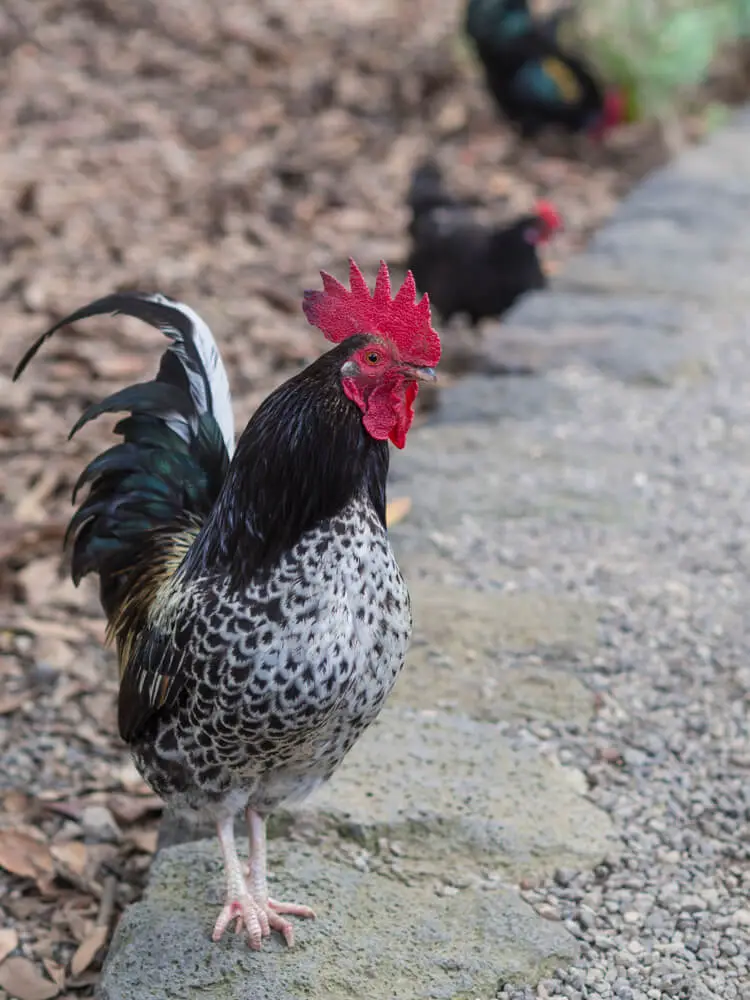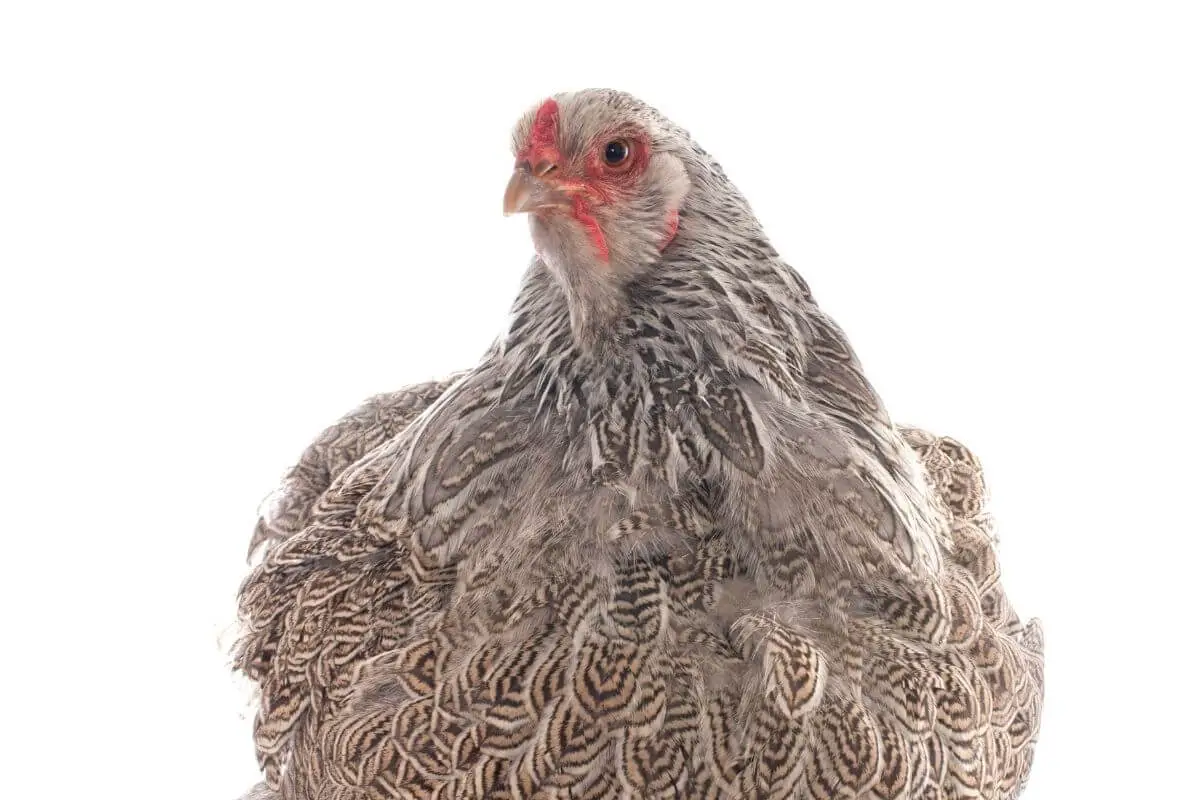Dark Brahma Chickens lay medium brown eggs throughout winter, typically producing 3 to 4 eggs per week. They are very friendly that grow large and make for the perfect dual-perfect breed for your backyard or small farm.
There are many reasons why you might consider getting Dark Brahma chickens for your backyard flock.
Dark Brahmas are a feather-footed breed that are known for their friendliness, and how easy they are to handle. They are a great breed for beginners and experts.
They are one of the first of their breed recognized by the American Standard of Perfection, and named a heritage breed by the American Poultry Association.
As with any chicken breed, you should carefully consider all the pros and cons before purchasing your birds to ensure you are getting the right breed for you.
Here is our list of the 10 things you need to consider before buying Dark Brahma Chickens:
Table of Contents
1. Dark Brahma Chickens are Extra Large Birds
Dark Brahma chickens have been called gentle giants, for their large size, and docile temperament. Due to their size, you will need to have a large chicken coop and plenty of land as they do enjoy free-range adventures.
They are comparable in size to a Cochin, and the two are often considered side by side.
However, if you have your heart set on a Dark Brahma but need a smaller bird, you‘re in luck because they do come in bantam varieties as well – they just may be more difficult to find.
2. You can Separate Dark Brahma Hens from the Roosters
Dark Brahma chickens have a unique appearance with a solid black chest, tail, and leg. Their shoulders are white and they have white and black striped saddle hackles and necks.
Unlike Light Brahma and Buff Brahma chickens, Dark Brahma roosters and pullets can be separated by their coloring and pattern, which makes it easier to sex them.
The key difference between a Dark Brahma hen and a Brahma rooster is the coloring and pattern of their feathers. Roosters will have black and silvery-white feathers, while hens have steel gray silver-penciled feathers.
3. Dark Brahma Chickens Have a Long Life Expectancy
Dark Brahma’s in general have a long life expectancy, with the average being 5 to 8 years. However, some can live 10 years or even longer with proper care.
These birds make excellent companions and are great with children and other animals. This makes them a good choice for backyard chicken owners if you are looking to keep these birds as pets.
4. Dark Brahma Hens are Copycat Brooders
Dark Brahma hens are not known to be a broody breed, however, if you have one hen go broody, it is highly likely that other hens will mimic the behavior. If you have a broody hen, keep a close eye on the rest of the flock if you don’t want the rest of them to copy her.
Another consideration if you’re a breeder and looking for lots of baby chicks, is that Dark Brahma mothers are so large that they can accidentally destroy their own eggs by mistake. To help combat this and get the most Brahma chicks possible, make sure the nesting boxes are quite large and well-padded to ensure even weight distribution.
5. Dark Brahma’s Can Have Mudballs and Fecal Balls on their Toes
Dark Brahma’s are a feather footed breed that also have feathered legs. The Brahma breed does not do well in muddy environments, and they do especially poor with heavy clay soil.
You may notice that your Dark Brahma’s have small mudballs or fecal balls resting on their toes, especially if they are allowed into a muddy area. You should immediately remove these balls as they are hazardous to the health of your birds.
The feathers on their feet can pick up a lot of wet soil quickly, and in winter, can cause frostbite by freezing on the toes of your birds.
Should you fail to remove these, their toes can become infected and if they are neglected, they can even lose their toes entirely. For the health and comfort of your birds, ensure you inspect your flock regularly, and give them all of the proper care necessary including routine vaccinations.
6. Dark Brahma’s are a Dual-Purpose Breed
Dark Brahma’s are meat birds in addition to being great egg layers. However, if you’re looking primarily to have them for meat production, you should know that their meat is the most delicious around the 8-month mark.

While you can butcher them at 8-12 weeks, you get much better quality by waiting until they mature.
7. Dark Brahma’s Eggs Provide Large Yolks
Dark Brahma‘s are great egg layers and produce brown eggs. The egg color can vary from a light to medium brown, and the egg size is medium.
Dark Brahma hens will produce 3 to 4 eggs per week and the yolk of the Dark Brahma egg is much larger than most chicken eggs, so they are prized by chefs for this reason.
This egg-laying breed produces such rich eggs that it is important to provide plenty of calcium by way of oyster shells in addition to their normal high-protein chicken feed to encourage egg production.
8. Dark Brahma’s are Made for Winter
Dark Brahma’s do exceptionally well in cold weather due to the small pea comb they have, and the incredibly dense feathering on their bodies. They were developed in Great Britain and bred for cool, moist environments.
Dark Brahma’s are one of only a few breeds of chicken that will lay eggs in Winter. For optimal egg production in winter, just be sure to provide them with places to roost and a comfortably large chicken coop to help keep them happy.
Just as they do well in cold environments, they do quite poorly in hot, humid climates because they can’t cool off. They have such dense feathering over the majority of their bodies, that they won’t be happy in hot weather.
9. Dark Brahma Chickens Have Slow Maturation
Dark Brahma’s are birds worth waiting for – at least admirers of the breed think so. However, you should factor in their rate of growth to determine if this breed is right for you.
Dark Brahma chickens are sometimes overlooked as a backyard chicken breed because they do not lay eggs as early as other breeds. Egg production typically doesn’t begin until a pullet reaches 6 or 7 months old compared to other types of chickens that may start laying at 4 or 5 months.
Their longer life span may make up for the difference of these few months, but this slow maturation in conjunction with having to wait for 8 months to get the best meat (should you raise them as broilers) needs to be taken into consideration.
10. Dark Brahma Roosters Will Not Protect the Flock
Most people would think that roosters will always protect their flocks. For Dark Brahma roosters, this is not true.
Dark Brahma’s are so friendly, and so docile, that they often are not aggressive enough to deter predators. If you have a flock of Dark Brahma hens, you will need to find other ways to supervise and protect them.

These birds will require extra predator-proofing, in the form of a sturdy chicken coop and extensive fencing to keep would-be attackers out. If you aren’t willing to put in the extra protection, you will not have many birds left.
Should You Buy A Dark Brahma?
Dark Brahma’s are wonderful birds but like any chicken breed, they have unique qualities that may mean they will (or won’t) work for you. This breed generally needs more time and attention from their keepers in order to keep them healthy and happy, but the rewards can be well worth it.

